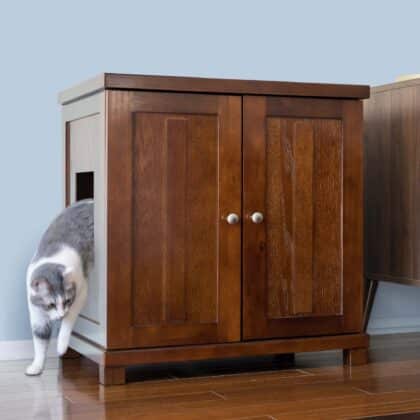
How To Help Feral Cats In Your Neighborhood
If you see a cat outside, it’s normal to worry about the furry feline. Outdoor cats typically fall into two categories, they’re either feral or stray. To help you figure out how to help outdoor cats in your neighborhood, The Refined Feline has put together all the basics on feral and stray cats.
What Is A “Feral” Cat?
For a long time, stray community cats were referred to as feral. The term feral usually refers to cats that are born outside and that have not had much contact with humans. Usually, they will either be afraid of people or be prepared to swat or bite if people come near. They see humans as potential predators against them, and will likely keep to themselves. However, there is a chance that with enough time and patience a feral cat will grow to enjoy being pet or even become a housecat over time.
Although it can be dangerous being on the streets, this is a feral cat home and it is all they know. If they are truly feral, they were born outside and don’t know that a home is a safe place. The streets are what is familiar to them, and what they consider home. Being taken out of that environment and going into a home can be very stressful for them. They might feel in danger being around people and in a strange place.
It can take months and usually years for them to feel safe in a home. The truly “feral” or undersocialized cats prefer to be outside, even though it’s much riskier. If a feral cat is brought to a shelter it will likely not be happy, won’t be adopted, and has a good chance of being euthanized. So, it’s important to determine if the cat is feral or a stray before you can figure out how to help.
How Can You Help A “Feral” Cat?
The best way to help a feral cat is by getting it fixed. This will prevent future litters of cats from being born outside and will also prevent the outdoor cats from fighting. Outdoor cats that are not neutered or spayed will often roam in search of a mate and will end up getting injured. Many counties offer free or low-cost programs. You can contact your local shelters for more information.
Unless the cat is in immediate danger or looks unhealthy, a feral cat should be left in its natural environment after being fixed. Moving a cat to a new outdoor location is tough because the cat will try to find its way home and will often be put in danger trying to do so. The cat may have to cross streets trying to get home and will be in unfamiliar territory.
You can also help a feral cat by offering an outdoor shelter to keep it warm and safe from prey or leave food for the cat if you are worried that it looks too thin. If a feral cat ever looks like it needs vet care, you can use a trap to catch the cat and find a vet that will treat feral cats. Some medications can be added to their food to treat certain conditions.
Related: 5 Myths About Fostering Cats
How Is a Stray Cat Different From A Feral Cat?
Oftentimes, a community cat is incorrectly referred to as a feral cat. However, many friendly cats find themselves outdoors and may prefer to live indoors and enjoy human contact. They may have been in a home at some point but became lost or abandoned or may have had enough positive interactions with people outdoors that they’re used to it. They may come right up to you for food or pets but may run away if you try to pick them up.
How Can You Help A Stray Cat?
If a friendly stray cat is not in immediate danger and doesn’t look sick, you can help by seeing if the cat is lost. Post photos of the cat on sites like Pawboost and Nextdoor and see if the cat is microchipped. If you can get them into a cat carrier and take it to the vet they will scan the cat for a microchip for free. You can also find a rescue group or a volunteer in your community to come out and scan the cat for a microchip if you’re worried about getting it into a carrier.
If the owner of the cat is not found and the cat wants to come inside, you can see how the cat reacts to being indoors. It may take some time to assess but if the cat eventually uses a litter box and seems content in a home it may be a good candidate for an indoor cat. If you live in a safe area away from predators and busy roads, the cat could also split its time between outdoor and indoor living. If the area is not safe, you can contact rescues to help in finding the cat an indoor home.
You can also help friendly outdoor cats by offering them food and water. Many cats that did not grow up outdoors aren’t capable of surviving on their own outside. They may not have the skills needed to hunt for food or to escape from predators.
How TNR Helps All Outdoor Cats
A lot of people in the animal welfare world are implementing TNR, which stands for Trap, Neuter, Return (or Release). This is broken down into three key phases:
- Trap: An area of community cats is selected and humane traps are set out. You’ll ideally get the majority of the cats in a first go-around. However, it will likely take multiple trappings to continue catching all the cats, especially if there are newcomers.
- Neuter: The cats will be brought to a vet clinic where they will be vaccinated. They will get spayed or neutered and if any of them have medical issues, these will be addressed.
- Return: Once the cats recover, they will be released back to where they were trapped.
TNR is the most humane and beneficial program for feral community cats. In previous years, many people would trap the felines and take them to their local shelter without assessing them first. This is not always an ideal outcome for community cats. Many of them are too scared and won’t be adopted, ultimately being humanely euthanized for space. Shelters also don’t have the time and resources to try getting them less fearful of humans either. So, that is why they should be assessed before just bringing them to a shelter.
Help Outdoor Cats By Volunteering
Are you interested in TNR and helping out your local felines? Any little bit of time or volunteer work helps! Whether you want to start your own TNR program or help out, the next stage is research. See if your town or city already has TNR set up through animal control or local rescue. You can team up and volunteer with them, or start your own if you don’t see one in your area!
You can also help by providing care for community cat colonies. These colonies are the groupings of community cats throughout the city or town. There can be multiple colonies or a single one if your town is small enough. Oftentimes, these colonies may need support with feeding.
You may also oversee their health, and contact a vet clinic if one of them looks injured or sick. You can build inexpensive enclosures for them during the rougher seasons, such as summer and winter. These shelters are made of many different materials to either help cool or warm cats, depending on the season. Be sure that they will be cleaned and maintained often so as not to cause further issues.
Talk With Your Neighbors About The Cats
Almost just as important to TNR is talking with your neighbors about it! Many communities and neighbors may be unfamiliar with the program or misinformed. So, talk with your neighbors about the work that’s being done and what’s needed. You may be surprised by how many people want to help!
You Can Help Outdoor Cats And Make A Difference
No matter how much time or energy you can devote to the community cats in your area you can make a difference! As each community comes together and helps out the local felines, it will only make the cats’ lives easier and healthier. It truly takes a village to help outdoor cats.










